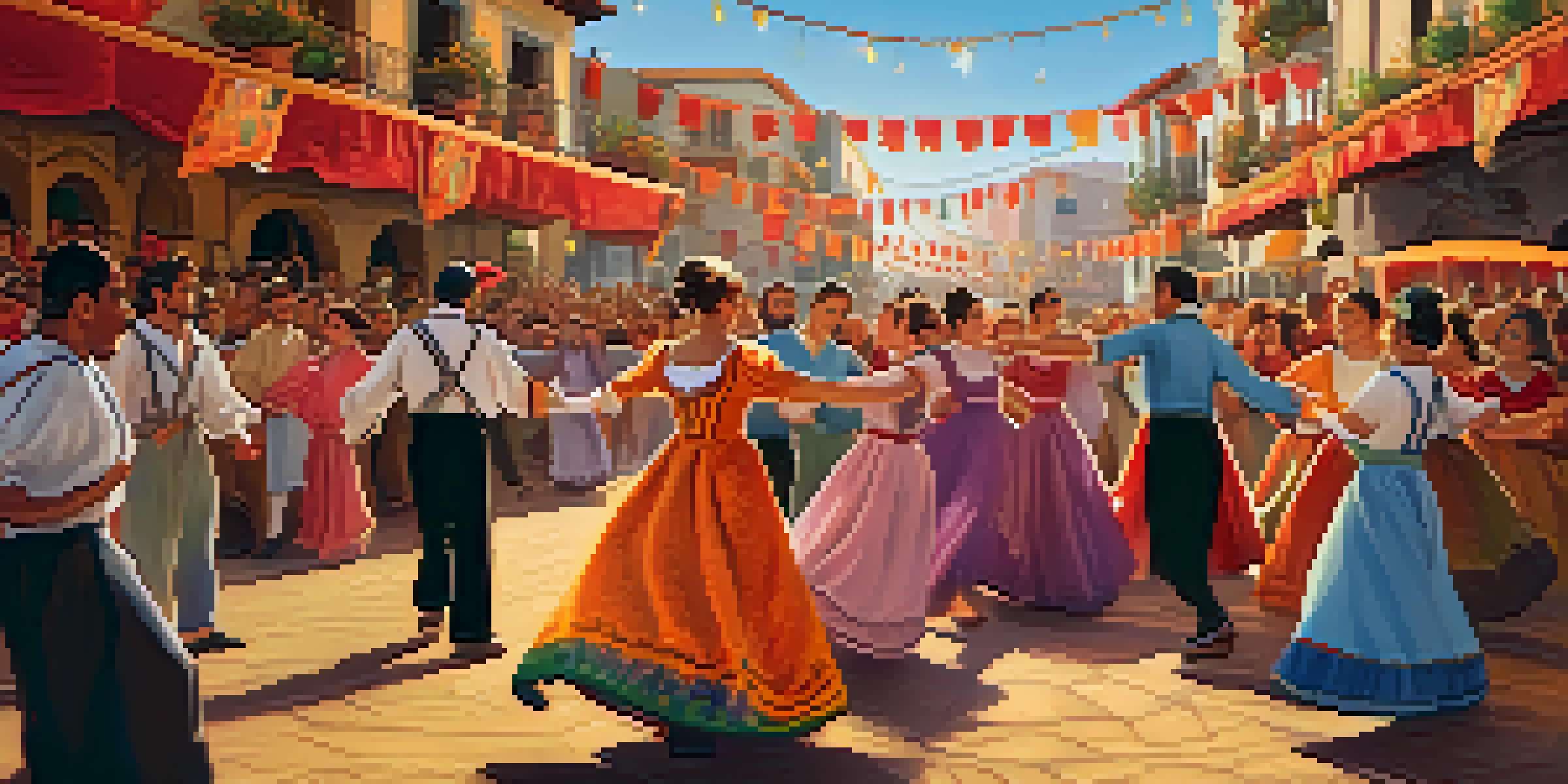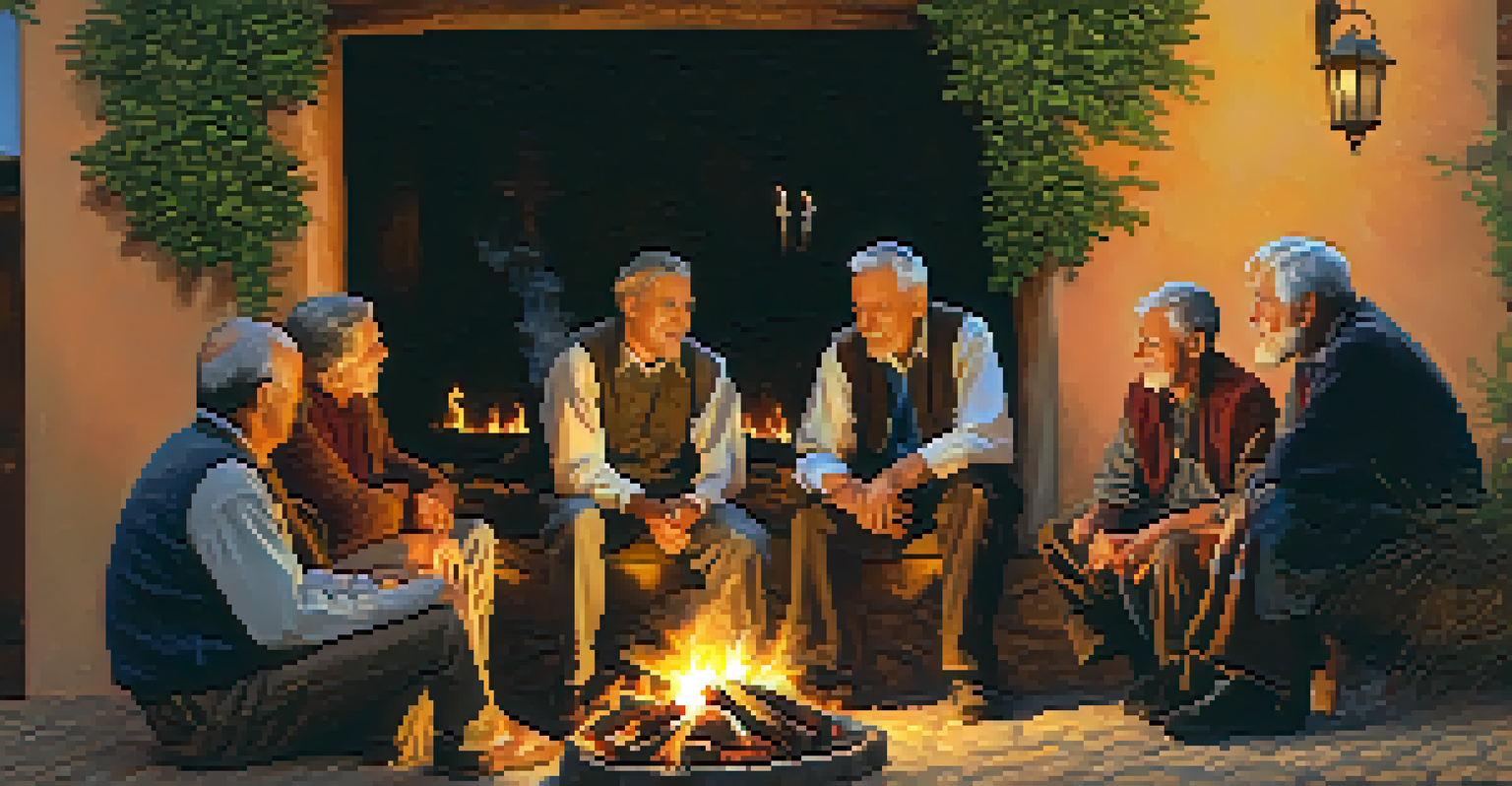Spanish Folklore: A Tapestry of Local Narratives

The Heart of Spanish Folklore: Culture and Tradition
Spanish folklore is a vibrant tapestry woven from the diverse cultures of its regions. Each community has its own unique stories, myths, and traditions that reflect local customs and history. These narratives serve as a window into the collective consciousness of the people, illustrating their values, fears, and dreams.
Folklore is the soul of a people, a reflection of their dreams, fears, and aspirations.
For instance, in Galicia, tales of the 'Moura'—mysterious enchantresses—are steeped in mystique and often involve nature and transformation. Such stories not only entertain but also pass down moral lessons and cultural identity through generations. This sense of belonging is crucial in preserving the heritage of Spain's many communities.
As we explore these local narratives, we see how folklore acts as a bridge connecting the past with the present. It allows modern Spaniards to engage with their roots while adapting to contemporary life, showcasing the dynamic nature of cultural storytelling.
Legends of the North: Basque and Galician Tales
In the northern regions of Spain, particularly the Basque Country and Galicia, folklore thrives with legends that reflect the rugged landscapes. The Basque tale of 'Miel Otxin,' a notorious sorcerer, highlights themes of power and morality, while Galician legends often feature a strong connection to the sea, echoing the region's maritime history.

These stories reveal the deep respect for nature and the mystical elements of life that characterize northern Spanish culture. The interplay of human experiences with the natural world illustrates how local narratives can convey broader existential themes. This relationship with nature is a recurring motif in many Spanish folktales.
Rich Diversity in Spanish Folklore
Spanish folklore reflects the unique cultures and traditions of its regions, serving as a bridge between past and present.
Moreover, the oral tradition in these regions keeps the tales alive, as elders share them with younger generations around fires or during community gatherings. This practice not only preserves the stories but also strengthens community bonds, reminding us of the importance of storytelling in fostering cultural identity.
Myths of the South: Andalucía's Enchantment
Andalucía, known for its vibrant culture, also boasts a rich folklore, filled with enchanting tales of romance and adventure. The legend of 'La Llorona,' a ghostly figure weeping for her lost children, evokes both fear and compassion, illustrating the complexity of human emotions in folklore.
Stories are the communal currency of humanity.
In this region, flamenco music and dance are often intertwined with local narratives, creating a multisensory experience that further enriches the stories. The rhythms and melodies echo the passion and heartache found within these tales, making them resonate deeply with both locals and visitors alike.
Furthermore, the fusion of Moorish, Christian, and Jewish influences in Andalucía's folklore reflects Spain's intricate history. This blending of cultures not only enhances the richness of the narratives but also showcases the coexistence of different traditions, creating a unique cultural mosaic.
The Influence of Oral Tradition in Spanish Folklore
Oral tradition plays a vital role in the preservation and dissemination of Spanish folklore. Stories are passed down through generations, allowing each storyteller to add their personal touch. This dynamic process not only keeps the folklore alive but also ensures it evolves with the times.
In rural areas, community gatherings often serve as platforms for sharing tales, where elders recount stories that captivate younger audiences. This practice fosters a sense of belonging and continuity, as listeners connect with their cultural roots through shared narratives.
Oral Tradition Preserves Narratives
The oral tradition is vital in keeping Spanish folklore alive, as storytellers pass down tales, adding personal touches that resonate with modern audiences.
The richness of oral tradition also highlights the importance of memory in folklore. Each retelling may vary slightly, reflecting the storyteller’s perspective and the audience’s reactions, making every performance a unique experience that keeps the spirit of the story alive.
Folklore Figures: From Heroes to Villains
Spanish folklore is populated with a diverse cast of characters, ranging from heroic figures like 'El Cid' to cunning tricksters like 'Joaquín el Famoso.' These characters embody the duality of human nature, showcasing both the admirable and the flawed aspects of society.
For example, the tale of 'El Cid' celebrates bravery and loyalty, serving as an inspiration for many Spaniards. In contrast, trickster figures often reveal the absurdities of life, allowing audiences to laugh at their own follies and misfortunes. This balance between heroism and folly reflects the complexities of the human experience.
Moreover, these characters often serve as vehicles for moral lessons, encouraging audiences to reflect on their values. Through their adventures and misadventures, these figures resonate with listeners, reminding them of the timeless qualities that define humanity.
Folklore Festivals: Celebrating Culture through Storytelling
Folklore festivals across Spain provide an opportunity to celebrate local narratives and traditions. Events like the 'Feria de Abril' in Seville and the 'Festa de Sant Joan' in Catalonia bring communities together to honor their cultural heritage through music, dance, and storytelling.
During these festivals, stories come to life as performers reenact traditional tales, allowing audiences to immerse themselves in the rich tapestry of folklore. This engagement fosters a sense of pride in their cultural identity and reinforces the importance of preserving these narratives for future generations.
Folklore's Modern Relevance
Contemporary adaptations of traditional tales highlight the ongoing significance of folklore in understanding cultural identity and the human experience.
Additionally, these celebrations promote cultural exchange, as visitors from different regions and countries experience the vibrant stories that define Spanish folklore. The sharing of narratives creates connections among people, highlighting the universal themes found in folklore across cultures.
The Modern Relevance of Spanish Folklore
As Spain continues to evolve, the relevance of folklore remains strong, adapting to contemporary themes and issues. Modern artists, writers, and filmmakers often draw inspiration from traditional tales, infusing them with modern sensibilities and perspectives.
This revival of interest in folklore encourages younger generations to explore their cultural heritage while also allowing for reinterpretation of classic stories. By blending traditional elements with contemporary narratives, these adaptations breathe new life into age-old tales, making them accessible and relatable for today's audiences.

In a rapidly changing world, Spanish folklore serves as a reminder of the importance of storytelling in understanding our identities. It connects us to our past while offering insights into the complexities of the human experience, reinforcing the timeless nature of these narratives.